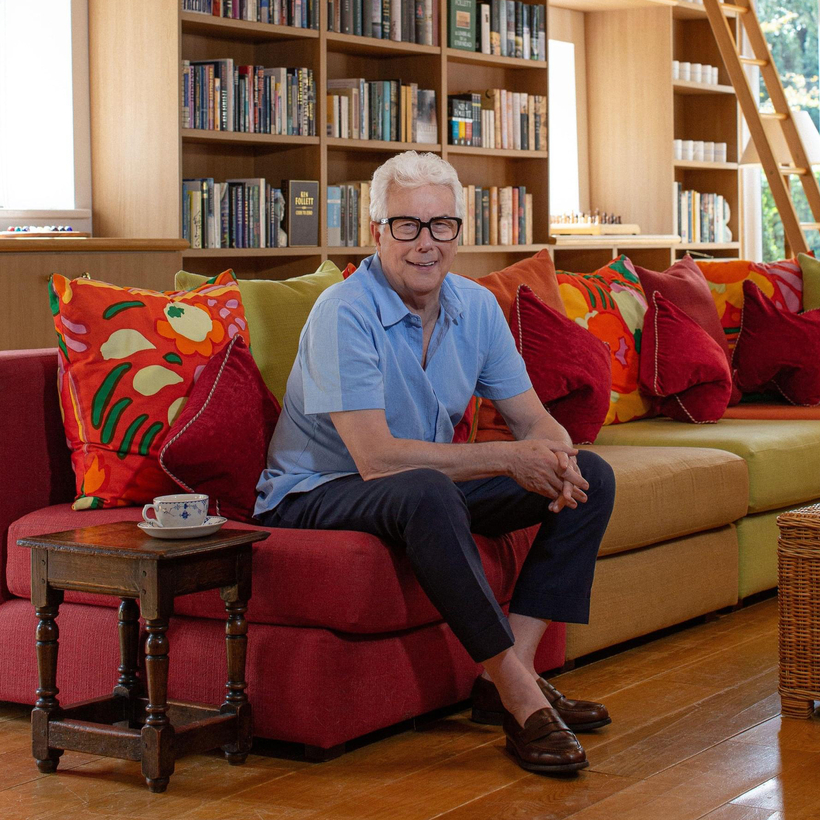If there is a literary terrain that Ken Follett can’t conquer, he hasn’t found it yet. His first taste of fame came in 1978 with his World War II thriller Eye of the Needle, which reads just as well today as back then, before we became engulfed by World War II thrillers. He dove into the medieval ages with The Pillars of the Earth in 1989, took on the 20th century with his trilogy focused on five families, and could not resist current times with Whiteout (2004), dealing with a deadly virus stolen from a lab. His latest work is Circle of Days, a deeply researched novel about how and why Stonehenge was built. Follett has sold more than 198 million copies of his books, and Circle of Days is so immersive and pleasurable that one should not be surprised if he soon passes the 200 million mark.
JIM KELLY: Stonehenge holds a powerful grip on our imagination, and has done so for hundreds of years. That said, given all the subjects you could write about, what drew you to write a novel centered around a circle of stones and set 2,500 years ago?
kEN FOLLETT: I was reading a book by Mike Pitts called How to Build Stonehenge—which is a nonfiction book—and as I was reading, I started to think about the story behind the monument and the people who must have built it. I realized very quickly that I had a story. For all its renown, there’s still so much mystery surrounding Stonehenge. Who built it? Why did they build it? How did they build it? I’ve always said that a good novel starts with a question, and there are so many unanswered questions about the monument, which makes it very fertile ground for a novelist.

J.K.: Theories abound on how and why Stonehenge was built, including the legend, before archaeologists got into the act, that Merlin had a hand in bringing the stones from Ireland. No spoilers here on your take (other than Merlin has no role!), but is it true that the populace at the time was divided into three such distinct groups—herders, farmers, and woodlanders—and that conflict was inevitable?
K.F.: We know that there was war in the Stone Age, because archaeologists found sites with thousands of stone arrowheads in the same place, far more than could be used up in a hunting expedition, so it seems highly likely that there was war. Herders and farmers all lived in England at the time, and it seems to me quite likely that there were hunter-gatherers, too, so conflicts over land seem likely. But this is not fact—it’s informed speculation.
J.K.: I doubt any of your readers will want their own D.I.Y. Stonehenge, but if they did, you do a terrific job of explaining how to do it. In fact, Circle of Days is filled with such fascinating detail about what life was like 2,500 years ago, including how to mine flint, the smartphone of its day. How much do you enjoy the research part of your historical fiction?
K.F.: I enjoy the research, in part because I know how much my readers have come to value all the intricate historical details that I try to include in my books. I get e-mails and letters from people who will tell me that they never liked history at school, that they found it boring, but that they enjoyed one of my books. Not only that, but they also learned something. I think that’s wonderful. So the research is important to me because I want what I write to be as accurate as possible for my readers.
It also takes me to a lot of fascinating places which I might otherwise never have visited, such as Grime’s Graves, in Norfolk, which is the site of a prehistoric flint mine, where you can go down nine yards into an old flint-mining pit. Fortunately, with a hard hat, torch, and safety gear—a far cry from the working conditions of the Anglo-Saxons.
J.K.: The Pillars of the Earth is another wonderful act of historical imagination, this time set in medieval England, and proved so popular that you wrote three sequels and one prequel. Again, you offer such wonderful detail about life then, especially on building a cathedral. I take it you are not exactly a religious person, so why a cathedral?
K.F.: I am an atheist now, though I was raised in a very religious household. Both my parents were deeply religious. However, even as a nonbeliever, I am a great admirer of cathedrals and have been fascinated with them since my early 20s. Whenever I visit a cathedral, I think to myself, “Who were the people who built this and why did they do it?” They were, after all, just ordinary people, and yet they created something ethereal and timeless. Something which remains standing hundreds of years later and which people like myself are still inescapably drawn to. The people of the Middle Ages had relatively few tools, comparatively speaking, and fairly limited resources, but they overcame all of that and built some of the most beautiful buildings. I think that it’s the motivation and reasoning of the people that built the cathedrals that I find so fascinating.
J.K.: You also wrote a trilogy following several families during the 20th century, which makes me ask how you manage to hit just the right note in capturing the way people think in such settings as 2500 B.C., 1600, and 1964. Seft, the flint-maker in Circle of Days, is smart and engaging, but his thinking process is different from, say, that of George Jakes, who is an aide to Robert F. Kennedy Jr. in Edge of Eternity (2014).
K.F.: It is impossible to know exactly what someone like Seft, alive in Stone Age Britain, would have thought, as nothing from that period was written down. However, I think that a lot of the things that motivate human beings have remained the same from era to era. We have the same fundamental wants—to fall in love, to succeed, to live happily—it is just how we go about it that has changed.
J.K.: I am old enough to have read Eye of the Needle when it first came out, and for me it is a perfect novel that also was made into a perfect movie, starring Donald Sutherland and Kate Nelligan. This, as you know, does not always happen. Were you involved in the movie? The film is so faithful to the book that you could have written the screenplay.

K.F.: I didn’t write the screenplay, no. Writing screenplays for film or television is a different skill set to writing a book, as you’ve got to know how to keep the viewer’s attention, especially now that there’s so many distractions with phones and everything else. So I tend to leave that sort of thing up to production companies and focus on writing books. It was a good adaptation, and I was very pleased with it. It’s always very flattering when someone says that they want to make a film out of one of your books, but, as you say, they’re not always very good. I’ve had mixed feelings in the past, but I was happy with Eye of the Needle and with the Pillars of the Earth mini-series. It starred a young Eddie Redmayne as Jack, and I thought he was terrific.
J.K.: Did your early career as a journalist shape you as a spy novelist? And is there a book you read as a child that made you fall in love with narrative?
K.F.: I’m not sure that I would say that my career as a journalist necessarily helped to shape me as a spy novelist, but it certainly helped me to develop as a writer. As a journalist, you’re writing all the time, and you have to ensure that you make things lively and interesting, much like in fiction. The thing that I liked most about being a journalist was listening to other people’s stories and writing about those.

I used to love visiting the library as a child, and once I’d read all the children’s books, the librarians allowed me to borrow books from the adults’ section. That was how, at about age 12, I discovered the James Bond books, by Ian Fleming. I thought they were brilliant. I think the first adult novel that I fell in love with was Live and Let Die. When I started writing fiction, my aim was to give readers the same excitement that I got from reading James Bond.
J.K.: Finally, if a tourist is strolling through the streets of the Basque city of Vitoria-Gasteiz, they might be surprised to see a life-size statue of you in front of its cathedral. How did that come about?
K.F.: I was pleased and flattered to be asked to sit for a statue of myself. My friends think it’s hilarious that the statue is outside a cathedral, like an image of a saint. Visitors take selfies and post them on social media. I’m very happy about it.
Jim Kelly is the Books Editor at Air Mail

